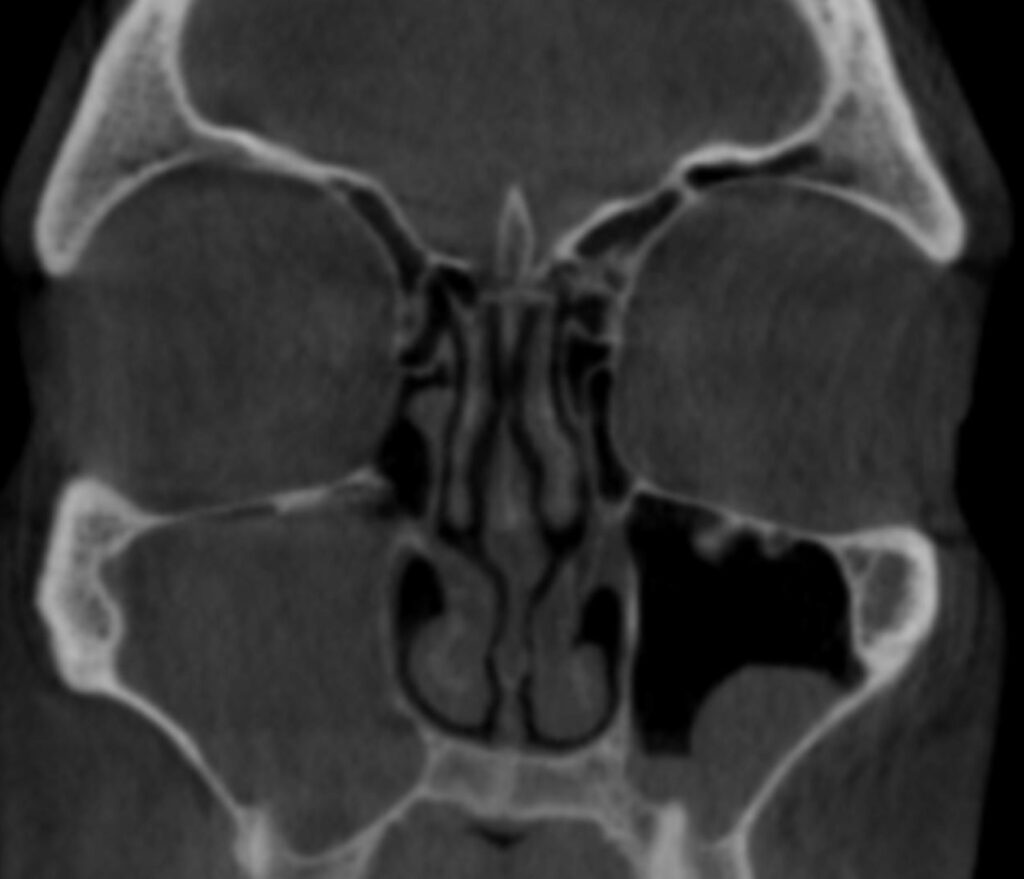What Is Chronic Sinusitis?

Sinus infections are bacterial, viral or fungal infections affecting the nasal passages and sinus cavities in the face and forehead. Sinusitis causes symptoms of headache, nasal blockage, runny nose, and eye pressure in addition to cold-like symptoms of cough, fatigue and fever. Chronic Sinusitis (CRS) exists when these infections are not clearing for several weeks despite treatment.
Many infections start as milder viruses, or even severe allergies, then go through a second longer phase of bacterial infection and abnormal inflammation response from your immune system. Medications such as antibiotics, nasal sprays, and anti-inflammatories are used but are not always effective.
or call (404)-943-0900 during business hours
What If Medicines Aren’t Working for Sinusitis?

You may be asked to see an Ear, Nose and Throat specialist for evaluation. Evaluation often include in-office sinus endoscopy, allergy testing review and/or sinus Xray CT scanning. Your medications will be reviewed, including antibiotic usage. A bacterial culture may even be done of nasal discharge.
Longstanding sinus infections may be treated with a couple of different sinus procedures – balloon sinuplasty or endoscopic sinus surgery. The principle of the procedures is to improve ventilation and airflow through the natural sinuses to allow infection to clear now and in the future. We aim to make the body’s immune system work better to help itself.
Balloon sinuplasty (“BSP”) uses a fine guidewire and small high-pressure balloons to stretch the sinus openings, creating micro-fractures in the thin sinus bones. This lets the sinuses drain, and helps to prevent future infections. This procedure is has a quick recovery time, low risks, and is shows effective for mild and moderate sinus infections. It has a big advantage of not requiring surgery in the operating room. Most patients drive themselves to and from the visit, and return to work the next day.
Endoscopic Sinus Surgery (“ESS” or “FESS”) is a more aggressive surgery in the operating room. Usually this surgery is done for more severe infections, nasal polyps, or perhaps when other sinus or nasal issues need to be addressed. This surgery is done under general anesthesia and uses camera endoscope guided cutting instruments. The principle is similar to BSP however in that the ultimate goal is opening up sinus channels and pathways; but endoscopic surgery also lets us remove bulky, scarred or abnormal tissue.
What Else Should We Look For?
Nasal airflow is very important to quality of life and quality of sleep. Many patients with very problematic sinusitis or allergies also have nasal breathing blockage. A deviated nasal septum is a deflected structural cartilage and bone element within the nose that can block off breathing and even contributes to recurring infections. Nasal turbinate hypertrophy is another anatomic problem that predisposes to worse congestion and trouble breathing and may be addressed along with other nasal procedures. Septoplasty and turbinate reduction are often done along with sinus surgery in chronic sinusitis patients. Other nasal concerns such as nasal valve collapse, lateral wall collapse, or cosmetic concerns (rhinoplasty) are also addressed as part of the surgical plan.

Allergies have been mentioned a few times already. Airborne allergies are probably the leading risk factor for chronic sinusitis. We recommend all CRS patients have an allergy evaluation. This usually involves skin prick testing but bloodwork can also be drawn. Patients with strong allergies are usually offered allergy immunotherapy to help with the chronic sinusitis battle. Allergy Drops from home or standard Allergy Shots in the office are available.
Patients with sinus infections that are recurring too often (more than 3 times yearly), or if requiring more than one round of an antibiotic should get evaluated by and Ear Nose & Throat specialist for chronic sinusitis. As with any health matter, diseases vary patient-to-patient and treatment results vary and are not guaranteed.
Dr. G. Aaron Rogers | Dr. Steven Bomeli | Dr. Sam Mickelson | Dr. Andris Golde
The current recommendation for most healthy patients is to wait about 7-10 after a sinus illness begins to start antibiotics. It has been shown that most of the time this is a viral illness and antibiotics too soon will just cause antibiotic side effects like stomach upset. Many patients with recurring or chronic infections may benefit from treating infections sooner. If you are someone having recurring or chronic infections, it is recommended to have a sinus evaluation and likely some imaging such as CT scanning or nasal endoscopy to get a handle on what’s going on.
Very rare! Most of the time sinus infections are a major nuisance, painful, harm your productivity but pose little serious risk. HOWEVER dozens of times a year our hospital has to admit patients with severe infections that have gotten out of control and start to infect the eye (orbital cellulitis) or even the brain or bloodstream. These are uncommon but do happen from time to time. Longstanding low grade infections or obstructions in the sphenoid sinus can cause headaches and are the most likley to spread to serious brain or eye complications.
Probably! We aren’t sure. But, the procedure is creating a permanent change in the bone structure of the sinus opening. It’s not just “pushing the swelling out of the way.” Ironically because this procedure uses specialized medical instrument regulated by the FDA, the success of balloon sinuplasty is actually more researched than regular sinus surgery – and the results long term are similar.
The sinuses are the hollow pockets in the bones of the face and front part of the skull. As surgeons we break these down into 5 regions on each side (frontal, anterior ethmoid, posterior ethmoid, maxillary and sphenoid sinuses). We generally try our best to quantify exactly which sinuses are affected and to what severity so we can plan targeted procedures.
There are some pretty good scoring systems for how bad sinuses look on CT scanning or with the scope. But every patient feels different about their sinus problems. We use a survey scoring system to measure how bad you feel about your sinuses, and know that the scores do not always match up to what we see on imaging or endoscopy. Every patient must be treated differently, paying great attention to the quality-of-life factors that present.
Some sinus infections are completely bad luck and due to structural problems that can be reversed and clear up. Many sinus problems are the end-result of immune system issues or ciliary-pump problems in the body. The sinus infections can be treated, optimized, but the nasal lining might always need attention from medication or allergy treatments for a longer time.
The scientist in me says “no way!” but alas I changed my tone when I got a sinus infection and felt unsteady and off kilter. Sinus infections should not cause a spinning vertigo symptom – if so then maybe the ears should be checked. BUT- when the eustachian tubes are not functioning well, and the head has pressure from trigeminal nerve discomfort of sinusitis, then you can get a complex “alterno-baric vertigo” causing a sensation of floating or rocking or vague unsteadiness while sick.
Some nasal sprays have been shown to have more positive effect on sinus infections than antibiotics or any other medication. Nasal sprays can reduce abnormal inflammation in the nose and promote better clearance of infectious material. We find nasal sprays very valuable. And fortunately there are several options out there now if you have found spraying things in your nose terrible in the past!
